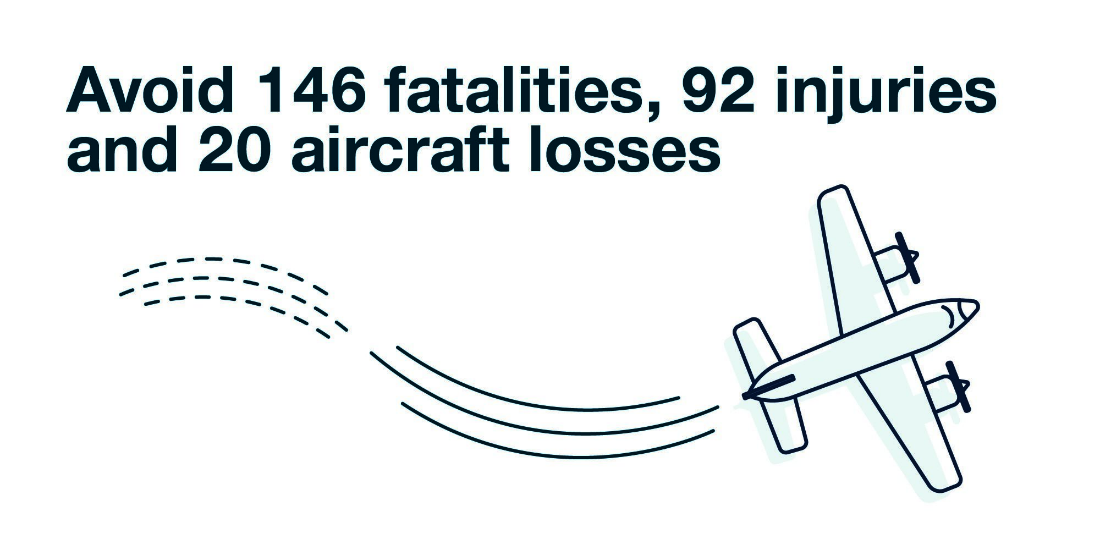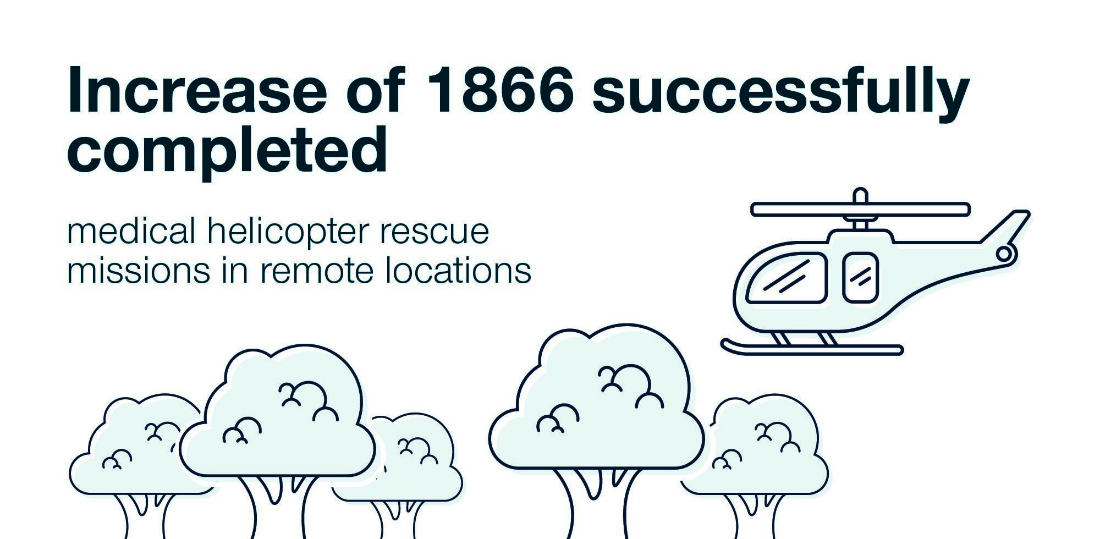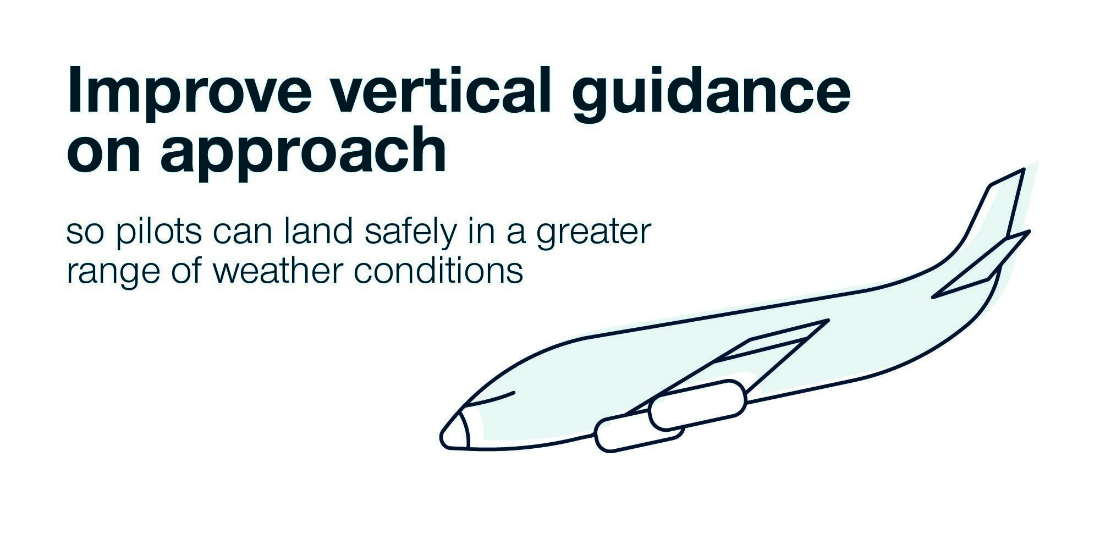Aviation
Page last updated:14 March 2025
Positioning technology revolutionised the way we fly and improves access to regional and remote Australia, and improves safety of landing approaches. Through Positioning Australia and the implementation of SouthPAN, aviation transportation will become even safer and efficient by improving vertical guidance.
A trial of SouthPAN’s accurate positioning technology, known as the Satellite-Based Augmentation System (SBAS) test-bed project, ran between 2017 and 2019 to assess the economic, social and environmental benefits of improved positioning technology through a range of industry demonstrator use case projects. These projects tested how SouthPAN could improve existing technologies, or give rise to new innovation, across the economy. SouthPAN’s SBAS test-bed included 27 demonstrator projects across ten industry sectors including agriculture, aviation, construction, consumer, resources, road, rail, maritime, mining and utilities.
This was led by Geoscience Australia in partnership with the New Zealand Government’s Toitū Te Whenua Land Information New Zealand and managed by FrontierSI.
Makes air travel safer
Aviation transportation will become safer and more efficient, with SouthPAN expected to reduce Controlled Flight Into Terrain (CFIT) accidents. SouthPAN can also be a backup system for Instrument Landing System (ILS) equipped airports in the case of outages, allowing for continued airport operations.
Improves access to regional and remote Australia
Improved satellite positioning technology allows for greater navigational accuracy when flying into rural and regional aerodromes such as the Royal Flying Doctor Service fleet. An increase in successfully completed rescue missions within remote locations will greatly benefit patients.
Enhances situational awareness
SouthPAN will provide the accuracy, integrity and availability of positioning signals needed for vertical guidance. This will improve the ability to land in a greater range of conditions such as low cloud cover and compromised visibility.
Satellite technology improving safety and efficiency in our skies
As part of SouthPAN’s SBAS test-bed project, Airservices Australia on behalf of the aviation industry, fit SouthPAN technology into aircrafts and tested it across regional Australia.
Additionally, Toll Air Ambulance and the Royal Flying Doctor Service demonstrated as part of the SouthPAN test-bed project, how SouthPAN technology could be used for patient rescue, retrieval and treatment, in communities in New South Wales and the ACT.
The aviation component of the trial tested two technologies: first and second generation SBAS services. An operational SouthPAN would improve safety, by guiding pilots with greater accuracy, especially those flying into regional aerodromes operating under Instrument Flight Rules (IFR).
The SouthPAN SBAS test-bed project demonstrated that SouthPAN technology provides accurate guidance for landing procedures at regional aerodromes where ground infrastructure may not be as advanced as that used at larger airports.
SouthPAN’s technology demonstrated that assisted aircraft approaches are eight times safer than those that use ground-based navigation aids.
This demonstrated that a pilot could attempt a landing without visuals down to 200 feet.
The safety and efficiency benefits SouthPAN technology provides will result in fewer flights being cancelled or diverted, and can also reduce the number of landing attempts flights may need to make during poor weather.
The SouthPAN SBAS test-bed highlighted that it would be of benefit to services like the Royal Flying Doctor Service, which provides emergency medical transport and primary health care to rural and remote Australia, and often needs to undertake landings in varying weather conditions and at small, remote airfields and other locations where infrastructure and technology is limited.
Airways New Zealand
Project Title
SouthPAN’s navigation benefits for the New Zealand aviation system
Organisations Involved
- Airways New Zealand
- Aeropath New Zealand
- Auckland Rescue Helicopter Trust
- IQ Aviation
- Helicopters Otago Ltd (Trading name Heliotago)
Project Summary
The improvements in manned & unmanned aircraft navigational accuracy and integrity delivered by SouthPAN could provide safety and efficiency benefits to the New Zealand aviation industry. Airways New Zealand utilised the flight inspection aircraft to verify the SouthPAN SBAS test-bed signal strength at controlled and uncontrolled aerodromes in New Zealand. This was in the course of, and to the extent reasonably achievable within, the Airways group’s scheduled flight inspection programme. The flight inspection equipment also compared the real-time performance of augmented GNSS with conventional and performance based navigation technologies. Additional testing was undertaken with rescue helicopter operators on assessing the benefits relating to medical centre and hospital helipad access including enroute helicopter routes during poor weather conditions.
The project proposed that SouthPAN’s SBAS test-bed project technology be installed for testing in aircrafts operating within the Airways group’s scheduled flight inspection programme only, except where additional testing was undertaken with helicopters. Aeropath, a subsidiary of Airways New Zealand, undertook assessment of instrument approach procedures to assess improvements in minima which could allow aircraft to land at aerodromes in poor weather conditions when currently they have to divert or not operate at all. Airways worked with project collaborators to assess the potential benefits of the SouthPAN technology.
This enabled the signal coverage and reliability to be tested at controlled and uncontrolled aerodromes during the period March to June 2018. Testing took place within New Zealand with the Chatham Islands an option. Airways NZ coordinated collection of data from SouthPAN’s receiving equipment. This included comparison of SouthPAN’s SBAS test-bed data with data produced by Airways NZ existing flight inspection equipment, where relevant, to assess the aviation benefits of SouthPAN to the New Zealand aviation system. This assessment included tests as follows:
- Test SouthPAN’s SBAS L1 and L1/L5 service coverage across the New Zealand aviation system. This verified signal reception at all controlled aerodromes, some uncontrolled aerodromes and heliports, and some low-level IFR routes.
- Test the reliability of SouthPAN’s SBAS L1 and L1/L5 signal in-flight for instrument approach requirements to enable revised minima for instrument approach.
- Assess the actual minima reduction from the use of SouthPAN’s SBAS at selected aerodromes. From this data assess the possible benefits from lower approach minima.
Airservices Australia
Project Title
SouthPAN’s benefits to the Australian aviation sector
Organisations Involved
- Airservices Australia
- ASTRA
- FrontierSI
- The University of Melbourne
Project Summary
Airservices Australia led a project on behalf of the Australian aviation industry to illustrate the safety and efficiency benefits of SouthPAN to airlines, regional/general aviation, and medivac operations. The project made use of SouthPAN’s SBAS test-bed signal to demonstrate the performance of the technology in an aviation context.
The SouthPAN SBAS test-bed project demonstrated the potential to provide a broad range of safety and efficiency benefits to the Australian aviation sector, particularly to rural and regional Australia. This project aimed to quantify these benefits and establish that the test-bed would meet the performance requirements of aviation. Verification of the test-bed as a Safety-of-Life system was outside the scope of this project.
This project:
- Demonstrated the compatibility of the SouthPAN’s SBAS test-bed with current generation avionics in an operational context (L1 SBAS)
- Tested the availability, accuracy, and coverage of SouthPAN’s SBAS test-bed signal from ground and airborne stations (L1 SBAS & L1/L5 SBAS)
- Assessed the safety and efficiency benefits of SouthPAN to the Australian aviation sector for a range of navigation and surveillance applications (L1 SBAS).
In particular, the project focussed on the use of SouthPAN to approach procedures in regional areas with limited ground infrastructure to improve the safety of medical evacuations and air-work.
Contact
For further information on these projects:
Eldar Rubinov
SBAS Test-bed Technical Manager
FrontierSI (formerly the Australia and New Zealand CRC for Spatial Information)
Door 34, Goods Shed, Village Street, Docklands, VIC, 3008
Tel: +61 406 966 992
Email: erubinov@frontiersi.com.au
www.frontiersi.com.au
For all media enquiries:
Tel: 1800 882 035
Email: media@ga.gov.au


